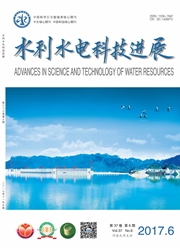

 中文摘要:
中文摘要:
为解决传统大坝变形监测方法仅能获取点变形信息,且监测周期长、劳动强度大等问题,将地基合成孔径雷达干涉(GBInSAR)变形监测新技术用于大坝变形监测.分析GBInSAR 变形监测系统及其成像特点,建立利用稳定参考点进行大气校正的数学模型,并应用于清江隔河岩大坝监测.结果表明:在距离1300 m 处大气扰动误差可达85 mm,雷达视线向大气扰动是影响GBInSAR 变形监测精度的主要因素;消除大气影响后GBInSAR 监测的坝体变形速率与垂线监测结果一致;大坝表孔泄水闸变形明显大于坝体变形,且随水位上升变形量增大.
 英文摘要:
英文摘要:
To overcome the disadvantages of conventional dam deformation monitoring methods, which are high labor intensity, long cycle, and acquiring of only pointwise information, a recently developed technology, called ground-based synthetic aperture radar interferometry ( GBInSAR) , was applied to dam deformation monitoring. Based on an analysis of the GBInSAR system and imaging characteristics, a numerical model for atmospheric phase correction using a stable reference point was established and applied to monitor the deformation of the Geheyan Dam. The results show that at a location of 1 300 m downstream of the dam, atmospheric disturbance caused an error of up to 85 mm. Atmospheric disturbance interfering with the sight of radars was the main factor decreasing the accuracy of dam deformation monitoring with GBInSAR technology. After elimination of the influence of atmospheric disturbance, the results of dam deformation monitoring with GBInSAR technology agreed with plummet observations. The results also show that the deformation of the water release gate at the surface outlet was significantly greater than the dam body deformation, and it increased with the rise of the water level.
 同期刊论文项目
同期刊论文项目
 同项目期刊论文
同项目期刊论文
 期刊信息
期刊信息
